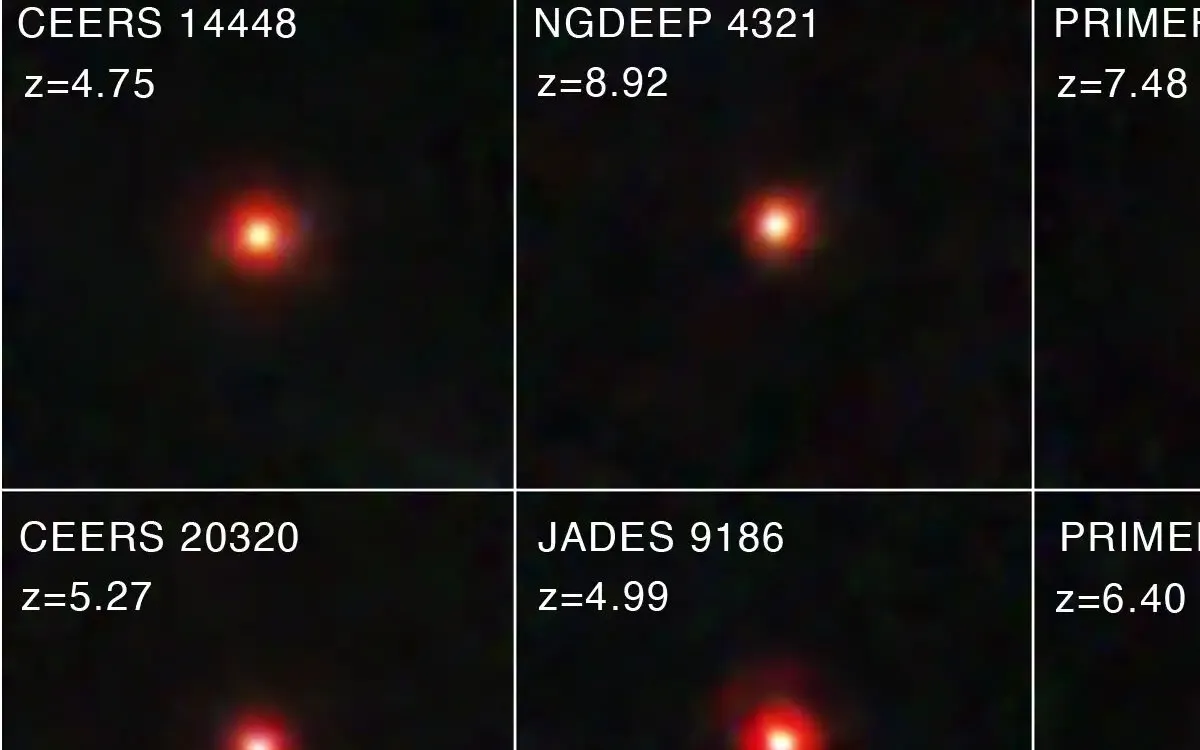
When the James Webb Space Telescope (JWST) commenced its operations, one of its primary objectives was to survey galaxies from the early universe. In December 2022, JWST's groundbreaking observations unveiled a series of intriguing objects, referred to as Little Red Dots (LRDs). These LRDs appeared as small red dots in the telescope's imagery, igniting fervent speculation regarding their nature and origin.
The prevailing consensus among astronomers is that these Little Red Dots represent compact, early galaxies. However, the scientific community remains divided over their composition and the reason behind their distinctive red appearance. One prominent theory, known as the stellar-only hypothesis, suggests that LRDs are predominantly composed of stars and dust, akin to the d dusty galaxies observed in today's universe.
Conversely, another compelling theory, the MBH and galaxy theory, proposes that LRDs may be early examples of active galactic nuclei (AGNs), which are prevalent in modern galaxies. Each of these theories carries significant implications for understanding how these galaxies evolved into the various types of galaxies observed in the later universe.
A recent paper published on the arXiv preprint server by a team of international astronomers explored these competing theories. Led by Andres Escala, a professor of astronomy at the Universidad de Chile, the research team included experts from the Astronomical Computing Institute at the University of Heidelberg, Yale University, and the Sapienza University of Rome. Their paper, titled On the Fate of Little Red Dots, is currently under review for publication in The Astrophysical Journal.
The discovery of LRDs has puzzled astronomers due to their unique characteristics, which resemble those of contemporary astronomical objects yet exhibit several differences. The stellar-only interpretation asserts that LRDs are intensely star-forming, dusty galaxies with exceptionally dense central regions. This explanation accounts for their compactness and vivid red hue, two defining traits of LRDs.
However, the widths of hydrogen spectral line emissions, specifically the Balmer-series lines, imply velocity dispersions that significantly exceed those typically seen in early galaxies. This discrepancy raises questions regarding the long-term stability of such structures. In contrast, the MBH interpretation is bolstered by the detection of broad Balmer emission lines, suggesting the presence of massive black holes at the centers of these galaxies.
Despite the promising evidence for both theories, it’s worth noting that many LRDs do not emit substantial amounts of X-ray radiation, which is a common signature found in quasars. Additionally, the black holes inferred to exist within these LRDs appear to be disproportionately massive compared to their host galaxies. As Professor Escala explained in an email to Universe Today, these two interpretations are favored due to their strong supporting evidence and the fact that they are considered less exotic than alternative explanations.
Interestingly, LRDs are unique in that they have never been observed before at low redshift values (z). The MBH and galaxy interpretation is particularly appealing as it aligns with the properties of similar objects in the local universe, albeit with notable differences in mass ratios. In the local universe, the mass of a supermassive black hole (SMBH) is typically around 0.1% of the total galactic mass. However, for LRDs, this ratio could be as high as 10%, indicating a significantly larger mass for the black holes relative to their host galaxies.
Escala and his colleagues began their analysis with the stellar-only interpretation but then explored how LRDs might evolve to align with the MBH and galaxy theory. Their proposed model seeks to unify these interpretations by suggesting that they represent different stages in the evolutionary timeline of these early galaxies.
According to their findings, LRDs could eventually host a supermassive black hole because the extreme densities within these galaxies imply that a substantial portion of their core regions is destined to form a massive black hole that exceeds the typical mass ratio of such objects to their host galaxies.
This evolutionary perspective on LRDs provides a more comprehensive understanding of JWST's observations of the early universe. The implications of this research could significantly reshape current models of cosmology and galactic evolution, particularly in light of the recent discovery of these highly compact and deep red galaxies. Professor Escala emphasized that LRDs are likely prime candidates for the formation of supermassive black holes, and even if these systems are primarily composed of stars, their inherent instability suggests that they will inevitably evolve to form MBHs.
In summary, the exploration of Little Red Dots is not only unraveling the mysteries of the early universe but also offering critical insights into the formation of supermassive black holes and the evolution of galaxies. As our understanding of these celestial phenomena deepens, it could pave the way for new discoveries in the field of astronomy.